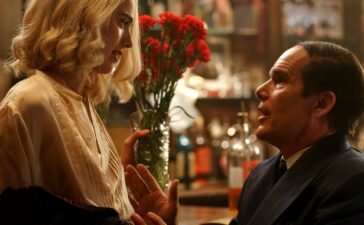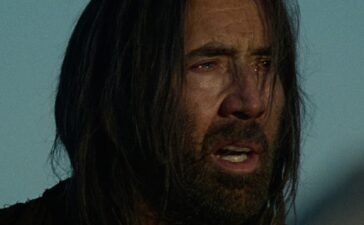
The film’s title, renamed from the story’s original Save the Green Planet!, speaks to a central fascination of Kubrick spanning from Lolita to Eyes Wide Shut. “Bugonia” refers to a mythological process holding that bees would spawn from the carcass of an ox. This sexual and reproductive anxiety is baked into the fabric of Bugonia as one species’ demise becomes another’s opportunity.
Concerned about colony collapse disorder and its downstream effects for natural life, Teddy takes up beekeeping with religious devotion for the preservation of humanity. Lanthimos, like Kubrick, understands the slippery slope when people enter into intensive regulation of sexual activity. Teddy’s monomaniacal asceticism demonstrates the destructive ends to which people are driven when they fixate on an act meant to generate life and pleasure.
While the setting of Bugonia is distinctly (and unfortunately) rooted in America of 2025, its dystopian-inflicted story of radicalized men feels distinctly of a piece with A Clockwork Orange. Regrettably, copycat criminals styled after the protagonist Alex DeLarge have complicated that film’s legacy. But those off-screen shenanigans do not dilute Kubrick’s analytical curiosity on-screen to help understand how antisocial behaviour develops – as well as why it’s so hard to curb once it has taken root.
Lanthimos and Tracy tackle the thorny nature of Teddy in an analogous fashion, refusing any easy explanation for his political violence. The character alludes vaguely to the various ideologies that he cycled through online before concluding that Earth is under attack by Andromedan aliens, an echo chamber mirrored in his secluded rural family home. The crime thriller leading up to Michelle’s abduction gives way to the trappings of claustrophobic captivity. The warping effects of social isolation, as horrifyingly demonstrated in The Shining, haunt the film as confinement pushes all the characters toward new psychological extremities.
Spoilers for Bugonia to follow.
Bugonia tips its hand even further toward Kubrickian antecedents as the standoff continues. Michelle’s strapped into an electronic torture chair meant to reprogram her like Alex’s Ludovico Technique in A Clockwork Orange. Don dies by suicide using a rifle placed in his mouth just as Pvt. Pyle does in Full Metal Jacket. Chapter divisions feature a vision of Earth viewed from a scientific remove, similar to the satellite imagery throughout 2001: A Space Odyssey.
That connection to Kubrick’s cosmic epic becomes even clearer when Michelle reveals that she is an alien, as Teddy theorized. After she returns to her home planet of Andromeda, a council acts on her recommendation that humankind must face immediate termination as a species. Following a telling moment of Michelle’s hesitation before dealing the death blow from above, Bugonia returns to the earth for a final montage of tableaus where all people have dropped dead instantaneously. Like Kubrick in 2001, Lanthimos can place himself so far outside humanity that he convincingly conjures a world without it.
The ironically soothing sounds of Marlene Dietrich’s “Where Have All the Flowers Gone?” form a direct allusion to the coda of Dr. Strangelove, which features test footage of nuclear detonations signaling the mutually assured destruction of humanity while Vera Lynn croons “We’ll Meet Again.” It’s a solidification of Lanthimos’ most powerful Kubrickian connection within Bugonia, a mordantly satiric take on how mankind’s folly will lead to its ultimate eradication. The silliness of these films’ exaggerated scenarios makes their eventual grim evaluations all the more devastating to contemplate.
The Kubrickian tendency toward fastidiousness implies an absence of sentimentality for the people it surveys with anthropological intrigue. But people are often more complicated than their personas, as many cinephiles discovered when Steven Spielberg pushed Kubrick’s long-time passion project A.I. Artificial Intelligence over the finish line. The film’s detractors assailed Spielberg for allegedly injecting his saccharine instincts into the film, assuming that Kubrick would have ended at the dead end for the humanoid robot David. But Spielberg clarified that he executed Kubrick’s original vision, which was to provide one final glimpse of humanity’s beauty even after carbon-based life had gone extinct.
While Dr. Strangelove offers no glimpse of any life continuing following the bomb drops, Lanthimos’ vision of a post-human earth shows evidence to the contrary. Putting the “dead” in “deadpan,” his parting statement reveals that animals, as well as other human-created technology, continue to roam the earth ignorantly of human obsolescence. Their manoeuvring around strewn bodies as Dietrich warbles “when will they ever learn?” is not a cynical epitaph for the species. Bugonia is Yorgos Lanthimos’ thoroughly Kubrickian appeal to recognize the humanity in each other before it’s too late.






